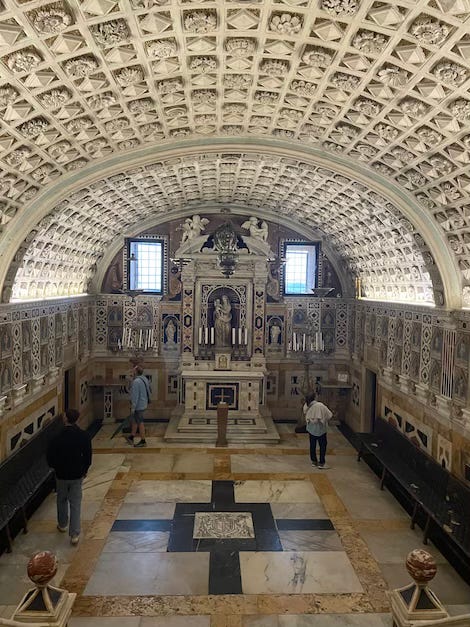Cagliari
After days of beach and leisure it was time to get serious with some sightseeing. The perfect place was close by, the old city of Cagliari. We were lucky to find a camper parking in the city, very close to what we wanted to see. We parked and walked down and up to come to the old city. We started with a cappuccino in an old, antique café with all the grandeur from times past. Just to get the energy to climb the stairs to the upper part of the city.
Beautifully situated on top of a hill with impressive stairs leading up to a plateau. After having admired the view, we took the small alleys further up into the old city and visited the Cathedral and the Archeological museum. Cathedrals are always impressive.
Not to talk about the crypt which consisted of several rooms and were beautifully decorated. Just as it should be in a place that hosts emperors and high ranking religious dignitairies.
The Archeological Museum
The museum was very interesting and we got acquainted with a new group of people. At least I have never heard of them before, the Nuragic civilisation. They originated in Sardinia during the Bronze Age, after what some experts think was due to multiple migrations from the West of people from the Beaker culture, while others think they were original to the island. Anyway, their culture lasted from the 18th century BC up until the Roman colonisation in 238 BC. Later on we visited their specially built villages and fortresses which are found all over Sardinia. Something quite different. Displayed at the museum is a stone with what the experts think is the oldest Fenician inscription found outside the Levant.
The Nora Stone, or Nora Inscription got its name from the place where it was found in 1773, Nora, on the south coast of Sardinia. It is an ancient Phoenician stone dated to late 9th to early 8th century BC. An interesting detail is that it is believed that the four letters marked in green on the right picture above, is a first ever reference to the name of Sardinia.
After so much culture for the mind it was time for something for the body. Martin had found a Michelin restaurant, or at least it had got a review as a possible one, and we headed there for an excellent 7 course dinner. Afterwards we were lucky to have about a kilometer to walk back to our van. It was even uphill so some of the extra calories were walked off. We slept well and woke upp ready to go to church.
The Basilica de Nostra Signora di Bonari
The Basilica de Nostra Signora di Bonari was close by. There was a mass going on so we could not visit the Madonna who had made wonders. The story goes like this.
A ship was travelling from Spain towards Italy on March 25, 1370, when it was seized by a terrible storm. All passengers and crew were at risk. The captain, in order to try to save the ship, ordered the sailors to empty the ship’s cargo into the sea. Inside the cargo there was a large crate which was the last to be thrown into the sea. As the crate hit the surface the storm ceased. The ship followed the crate for some time, but could not get hold of it. The ship continued and returned to its original route. The crate took another route though, and finally ran aground on the beach at the foot of the hill of Bonaria.
People on the shore had noticed the crate and rushed to see what it was. They tried to open it, but did not succeed. They tried to lift it, but in vain. A child then cried out: “Call for one of the Mercedarian Friars!” The friars came and surprisingly, without any difficulty, they raised the crate and carried it into their church. When they opened the crate there was a marvellous statue of the Blessed Virgin Mary and Child in her arms. And, in her right hand, a lighted candle.(!) Miracles seem to happen.
The Basilica and other structures around it, as well as the shrine, are still administered by the Mercedarians, and have been done so since October 17, 1335. The Basilica is surrounded by a beautiful park with magnificent views over the city and the sea. I think the Madonna and Child have got a great home, after all their adventures.









